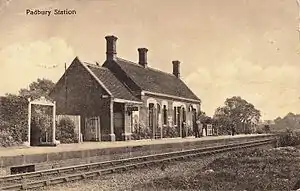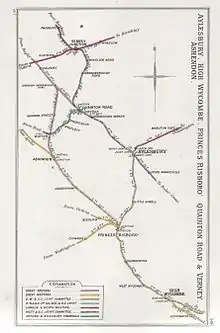Padbury railway station
Padbury railway station served the village of Padbury in the English county of Buckinghamshire. It opened in 1878 as part of the Buckinghamshire Railway's branch line to Verney Junction which provided connections to Banbury, Bletchley and Oxford and closed in 1964.
Padbury | |
|---|---|
 | |
| Location | Padbury, Buckinghamshire England |
| Grid reference | SP713305 |
| Platforms | 1 |
| Other information | |
| Status | Disused |
| History | |
| Original company | Buckinghamshire Railway |
| Pre-grouping | London and North Western Railway |
| Post-grouping | London, Midland and Scottish Railway London Midland Region of British Railways |
| Key dates | |
| 1 March 1878 | Opened |
| 6 January 1964 | Goods facilities withdrawn |
| 7 September 1964 | Closed |
History
The Buckinghamshire Railway's line from Banbury to Verney Junction opened to passengers on 1 May 1850.[1] It had been originally planned to provide a station to serve the Buckinghamshire village of Padbury at a projected cost of £3,000 (equivalent to £280,000 in 2019)[2] but this did not materialise, possibly as a result of necessary economies.[3] It was not until 1 March 1878 that a station was opened at Padbury.[4][5] The London and North Western Railway, which had worked the line from its opening and which absorbed the Buckinghamshire Railway in 1879,[6][7][8] advised the Board of Trade in January 1878 that a station was being built at Padbury and that a siding had been laid to facilitate construction.[9] The points to the siding were locked and an Annett's key was held by the Verney Junction stationmaster from whom it had to be collected and returned after each working to the siding.[9][10]

A simple single storey red brick station building with a gable roof was provided at Padbury.[10] No provision was made for the stationmaster who was expected to live in one of the nearby houses, as was the case for the Banbury Merton Street's stationmaster.[11] As with Farthinghoe railway station, the station had a single platform, 250 ft (76 m) long,[9] but unlike Farthinghoe it was conveniently situated to the west of the village of 650 inhabitants that it served.[11][12] The station's siding ran in to the station forecourt to a point adjacent to the main station building; nearby were a cattle landing, weighbridge and hut.[13][14] The siding, which was controlled by a six-lever ground frame and was released by an electric token, accommodated four or five coal wagons a week, together with milk traffic for the United Dairies factory in Buckingham and the village's requirements.[15]
Padbury ceased to have its own stationmaster in 1928 upon the retirement of Levi Ambler.[15] The station then came under the control of the stationmaster at Buckingham railway station who gave instructions to the remaining staff consisting of a single porter and junior assistant.[15] From 1942 the station's staff consisted of a single lady porter, Bertha Allen, who was employed by the London, Midland and Scottish Railway (LMS) as temporary wartime cover, but instead remained for a further twenty-four years until the station's closure.[15][16][10] In 1960, the section of the line between Banbury and Buckingham was closed,[17] with the remaining section lasting four more years. Padbury station was listed for closure by the Beeching report[18] and it duly closed to goods traffic on 6 January 1964[19] and to passenger traffic on 7 September 1964.[4][5] The track was however not removed immediately and Padbury was thus able to accommodate the Royal Train for an overnight stay on 3/4 April 1966 for a visit by the Queen and the Duke of Edinburgh to Buckingham.[20][21]

| Preceding station | Disused railways | Following station | ||
|---|---|---|---|---|
| Buckingham | London and North Western Railway Banbury to Verney Junction Branch Line |
Verney Junction |
Present day
The station buildings were demolished in 1968 and the site was cleared.[22] By 1975, construction of a small housing estate had commenced which now occupies the site.[22][23][24][25] Just south of Padbury station a skew bridge took the line over Main Street which led into the village; no trace of this bridge remains.[26] The course of the line to the south of the station followed a shallow cutting which is now infilled and returned to agriculture.[27]
References
Notes
- Simpson 1994, p. 24.
- UK Retail Price Index inflation figures are based on data from Clark, Gregory (2017). "The Annual RPI and Average Earnings for Britain, 1209 to Present (New Series)". MeasuringWorth. Retrieved 2 February 2020.
- Simpson 1994, p. 18.
- Butt 1995, p. 180.
- Quick 2009, p. 303.
- Oppitz 2000, p. 53.
- Awdry 1990, p. 63.
- Davies & Grant 1984, p. 102.
- Preston Hendry & Powell Hendry 2001, p. 141.
- Simpson 2005, p. 57.
- Simpson 1994, p. 121.
- Mitchell & Smith 2005, fig. XX.
- Mitchell & Smith 2005, fig. XX and 99.
- Simpson 2005, pp. 57-58.
- Simpson 1994, p. 125.
- Mitchell & Smith 2005, fig. 98.
- Simpson 1994, p. 113.
- Beeching 1963, p. 117.
- Clinker 1978, p. 105.
- Simpson 1994, p. 118.
- Davies & Grant 1984, p. 107.
- Simpson 1994, p. 131.
- Mitchell & Smith 2005, fig. 99.
- Davies & Grant 1984, p. 221.
- "Disused Stations". Subterranea Britannica.
- Simpson 2005, p. 61.
- Shannon 1996, p. 120.
Sources
- Awdry, Christopher (1990). Encyclopaedia of British Railway Companies. Sparkford: Patrick Stephens Ltd. ISBN 1-8526-0049-7. OCLC 19514063. CN 8983.
- Beeching, Richard (1963). "The Reshaping of British Railways" (PDF). HMSO.
- Butt, R. V. J. (1995). The Directory of Railway Stations: details every public and private passenger station, halt, platform and stopping place, past and present (1st ed.). Sparkford: Patrick Stephens Ltd. ISBN 978-1-85260-508-7. OCLC 60251199.
- Clinker, C.R. (October 1978). Clinker's Register of Closed Passenger Stations and Goods Depots in England, Scotland and Wales 1830-1977. Bristol, Avon: Avon-AngliA Publications & Services. ISBN 0-905466-19-5.
- Davies, R.; Grant, M.D. (1984) [1975]. Forgotten Railways: Chilterns and Cotswolds. Newton Abbot, Devon: David St John Thomas. ISBN 0-946537-07-0.
- Oppitz, Leslie (2000). Lost Railways of the Chilterns. Newbury, Berkshire: Countryside Books. ISBN 978-1-84674-108-1.
- Mitchell, Vic; Smith, Keith (July 2005). Oxford to Bletchley (Country Railway Routes). Midhurst, West Sussex: Middleton Press. ISBN 978-1-904474-57-9.
- Preston Hendry, R.; Powell Hendry, R. (2001) [1982]. A Historical Survey of selected LMS Stations: Layouts and Illustrations. 1. Hersham, Surrey: Oxford Publishing Co. ISBN 978-0-860931-68-3.
- Quick, Michael (2009) [2001]. Railway passenger stations in Great Britain: a chronology (4th ed.). Oxford: Railway and Canal Historical Society. ISBN 978-0-901461-57-5. OCLC 612226077.
- Shannon, Paul (1996) [1995]. British Railways Past and Present: Buckinghamshire, Bedfordshire and West Hertfordshire. Wadenhoe, Peterborough: Past & Present Publishing. ISBN 978-1-85895-073-0. No. 24.
- Simpson, Bill (2005). Banbury and the branch line to Verney Junction. Witney, Oxon: Lamplight Publications. ISBN 978-1-899246-15-1.
- Simpson, Bill (1994) [1978]. Banbury to Verney Junction Branch. Banbury, Oxon: Lamplight Publications. ISBN 978-1-899246-00-7.